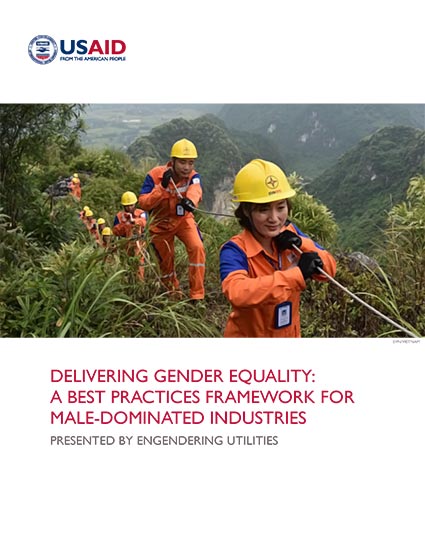- Energy Home
- How We Work
- Programs & Initiatives
- EmPOWERing Women and Girls
- Competitive Energy Procurement
- Toolkits
- Monitoring & Evaluation
- Resources
- Stories
Speeches Shim
A Best Practices Framework for Increasing Gender Equality in Male-Dominated Industries
This framework provides the practical resources organizations need to increase gender equality across their operations and corporate structure.
Women represent half of the world’s employment potential, and effectively developing this talent will increase an organization's competitive advantage. A growing body of evidence demonstrates a correlation between gender diversity at the executive level and company performance. A recent study by McKinsey analyzed more than 1,000 companies in 12 countries and concluded that gender-diverse companies are more likely to outperform their national industry average in terms of profitability.
Despite the evidence demonstrating women’s value in the workforce, women continue to encounter structural barriers to participating in the world economy, particularly in industries traditionally dominated by men. Globally, the labor force participation rate for women is 27 percent lower than the rate for men. On average, women work fewer hours for pay or profit either because they opt to work part-time or because part-time work is the only option available to them. In some countries, gender gaps in hourly wage rates for similar work can reach 40 percent. According to the World Economic Forum (WEF), with current trends, the overall global gender gap can only be closed in 108 years.
The U.S. Agency for International Development (USAID) increases women’s participation in the global workforce to strengthen economies, fuel economic growth, and catalyze social development. Through its Engendering Utilities program, USAID identified the employee life cycle as a key entry point to effecting long-lasting and impactful change within partner organizations. From attraction and talent outreach to separation and retirement, there are numerous opportunities to promote gender equality within organizations. To serve as a guide for implementing gender equity practices throughout the employee life cycle, USAID developed this Practices Framework.
The framework is divided into 12 categories, eight of which are part of the employee life cycle:
- Attraction and Talent Outreach
- Recruiting and Hiring
- Onboarding and Training
- Performance Management, Compensation, and Benefits
- Talent and Leadership Development
- Retention and Employee Engagement
- Succession Planning and Promotion
- Separation and Retirement
The last four categories represent organization enablers for gender equality:
- Policies and Grievance Management
- Company Performance and Reporting
- Corporate Communications and Branding
- Corporate Culture and Leadership.
Within each category, multiple best practices are outlined that are derived from an extensive literature review of global resources and complemented by lessons learned from USAID’s Engendering Utilities program. A description is provided for each best practice, as well as potential implementation challenges; examples of successful implementation; and tools, resources and templates that provide additional information on each best practice.


Comment
Make a general inquiry or suggest an improvement.